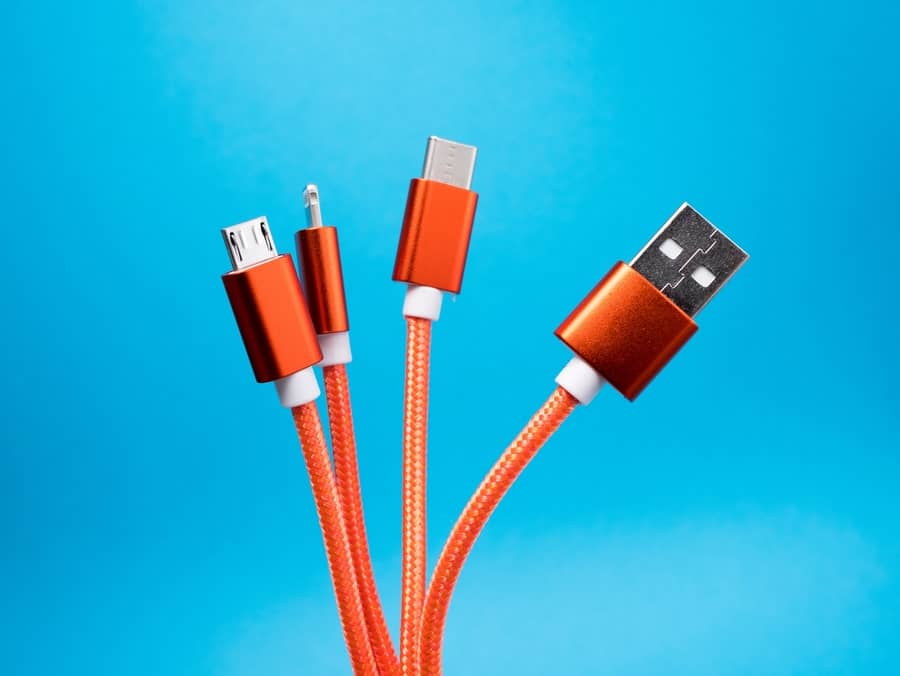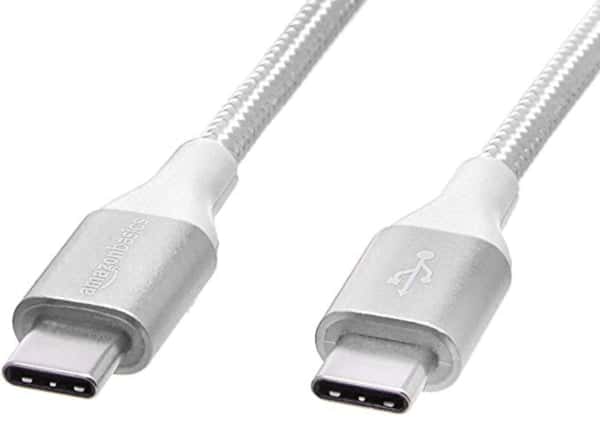
With every new electronic device that gets introduced into our household, we most likely adopt yet another USB cable that’s included in the box.
Of course, the more USB cords that we inherit, the more clutter that accumulates in places to the point that we wish the same cables can be compatible with all our gadgets.
So are USB cables universal?
USB cables that share the same type are universal. However, there are now different types of USB cables and ports that range in shape and size, and therefore, are not universal with other type USB cables without the use of an adapter.
Even though the “U” in the name “USB” stands for universal, there are several types under USB that are not universal with each other.
Read on as I share my experiences and research to help clarify how some USB cables are the same and interchangeable, while others are quite different.
Are USB Cables All The Same?
There’s no doubt that we all have a handful of USB Cables laying somewhere around the car, house or office, whether they came from the box of a new gadget that we just bought, or whether they were just ordered because they got lost in the pile.
But aren’t USB cables all the same? Can’t we just eliminate the clutter and keep just one cable for all of our devices?
The short answer: some USB cables are universal while others are not.
Here is the more in-depth explanation. When USB first came out, the purpose was to create a port, with an accompanying cable, that was universal across all computer devices.
At first it worked, more and more new devices were adopting USB as its new standard port. However, this was just the beginning.
Fast forward to now, there are all kinds of different laptops, tablets, and smartphones that range in shape, size, and requirements for speed.
It actually got to the point that the original USB, now referred to as “Type-A”, is to big and bulky to fit into some of our smallest devices. This creates a growing need for smaller and smaller ports.
So now, instead of using larger gadgets, like computers, that can easily house USB Type-A ports, we are also using much smaller gadgets, like Airpods and their cases, that need slimmer and sleeker means of charging.
To give you a rundown of just how many types of USB there are today… we now have, not just the original USB Type-A, but also USB Type-B (the square one that’s usually found on the back of home office printers), Mini USB, Micro USB, and the latest USB Type-C… just to name a few.
Another kind of “USB style” port that also needs to be considered is that of manufacturers who incorporate their own proprietary design, like Apple’s lightning port.
This type of port is designed to only work with Apple-made devices, along with it’s specific cable that fits the lightning port, while leaving other manufacturers out of the lightning pin-style party.
As a side note: after several months of using the lightning cable that Apple supplies with their devices with the charger in the box, you might notice the plastic wears or turtle-necks towards the connectors, creating a weak spot for bends.
I used to use these all the time, especially in my truck, but after ending up in the middle of a parking lot with a fried cable that couldn’t connect my iPhone to CarPlay, I’ve switched to using the Anker Double Braided Lightning USB Cable to connect my phone, and I haven’t had a problem yet. If you’re looking for a new iPhone charging cable because you’re not happy with your last one, I highly recommend this one.
Now back to the original question!
With every new USB type (and version of that type) of port that releases, there is a different USB cable that’s required in order to connect to that unique port.
So in other words, the new USB Type-C features a port that’s much slimmer and rounder than the original USB Type-A. I can actually get used to the new Type-C since you no longer have to worry about which way the cable goes in with this new port.
But because the Type C port is a different shape, and a much smaller size, than Type A, the USB cable that fits into that port needs to have a Type C connector on its end.
Remember: the new USB Type C cable connector will not fit in to a USB Type A port, and they are therefore not universal with each other, since the two are completely different shapes and sizes.
But say you have two USB cables that have the same type connector at the end, will they both fit in the same type USB port?
The answer is yes. As long as they are of the same type, ie. Type-A, Micro, Mini, Type-C, etc., they will fit into the same respective USB type port.
So if you have five Micro USB cables that have a Type-A USB connector on the other end, you can interchange the five as you please, or maybe throw a few in the recycle bin if you don’t need that many.
As a rule of thumb: when you come across a new type of USB cable with a different type of connector on the end of it, you should keep it. Since the cable will only connect its respective type USB port, other type USB cables will not work in its place, and so you should hold on to it.
Do All USB Cables Transfer Data?

Ever since its very beginnings to this day, all USB cable can not only supply power, but can transfer data as well.
This is because there are two wires within USB cables that each have their own purpose: one for charging and supplying power, and the other for transferring the data.
However, depending on the type of USB cable and the version of its type, cables are capable of transferring data at different speeds.
Older Type-A USB cables could only withstand just a few megabytes per second of data transfer, which is also what the gadgets and their USB Type A ports could handle back then.
Today, newer Type C cables can handle up to several gigabytes of data per second, keeping pace with modern device needs of moving larger files, such as higher-quality photos, music, and documents.
Here is another thing to consider.
Although all USB cables can, indeed, transfer data, not all USB ports can accept or send data. This means that a certain device, say the Micro USB port of a bluetooth speaker, can come with a Micro USB cable that can transfer data, but the port is only designed for charging purposes.
If that is the case, you will only be able to charge that certain device and not transfer its data. However, you can use its USB cable to transfer data with devices that also accept the same type USB.
Are USB 2.0 And 3.0 Cables The Same?
Since the advent of USB, there have since been newer and more updated iterations of the same type in order to solve the growing need for faster data transfers.
With USB ports that can now accept several gigabytes of information per second, older USB cables cannot handle data transfer of that speed, and therefore, require newer cables that can.
This is the case between USB 2.0 and 3.0.
The two cables, although the same shape and size of connector type, are different inside. USB 2.0 has less wiring, and can appear much thinner in gauge compared to a USB 3.0 cable. It also cannot withstand data transfers of anything more than a few hundred megabits per second at its most recent (around 480 megabits per second is the consensus).
However, with the release of the newer USB 3.0 cable, it can now handle up to 10 times the transfer of data (5000 mb/s or 5gb/s) as its older sibling.
And you can notice it too. The wiring inside results in a visibly thicker gauge for the 3.0, and to confirm that it is indeed 3.0, there is a standardized blue color on the tab inside the connector to show that it is the newer USB cable.
But can USB 3.0 ports accept USB 2.0 cables?
So you may have a bunch of USB 2.0 cables laying around the house, and are in a pinch to transfer data from one device to another that has USB 3.0 ports.
As long as the information you want to transfer isn’t humungous in size, USB 2.0 will connect to and work with USB 3.0 ports. The only limitation to connecting the older cable to the newer port is that it will only transfer data as fast as the weakest link, which is the 2.0 cable speed (few hundred mb/s).
Here is another scenario: you may have a brand new USB 3.0 external hard drive with a USB 3.0 cable that came with it, but are transferring data from an older device that has a USB 2.0 port… will it work?
The two devices can, in fact, transfer data with each other since they are the same type. But since they are of different iterations, the transfer of data can only occur at the speed of its slowest counterpart, which is the USB 2.0 of the older device (also a few hundred mb/s).
As a result, in order to harness the break-neck speed of the 5000 Mb/s (or 5 Gb/s) of transfer speed that USB 3.0 can obtain, every piece of the connection needs to be USB 3.0. Otherwise your data will only transfer at its slowest connection.
Recommended Products That Helped Me Research This Article
- AmazonBasics Double Braided Nylon USB Type-C to Type-C 2.0 Charger Cable | 10 feet (check out here on Amazon) – If you’re like me, you love to travel around with your laptop and its charger. But some of these charging cables just aren’t strong enough to withstand the normal wears and tears of commuting life. That’s why I love and personally use this AmazonBasics double braided cable for my MacBook Air. It doesn’t crease or tangle like the original cable that’s included in the box, and its extra length eases any plug range anxiety when its time to juice up, so you can keep you laptop right where it’s at.
- Anker Premium Double-Braided MFi Lightning USB Cable (check out here on Amazon) – Thanks to its tough braided design, the USB cable by Anker won’t kink, turtle neck, or bend, and is durable enough for everyday driving, along with all its extreme temperatures. Long-lasting cable quality from Anker that we all expect delivers a pure, premium audio experience from your iOS device.
